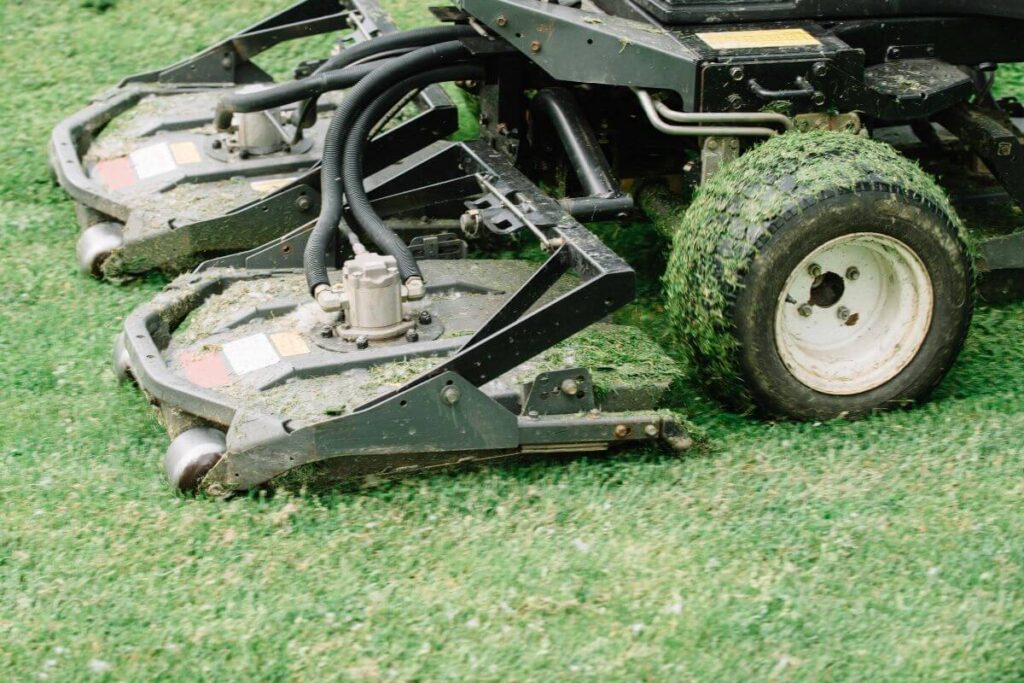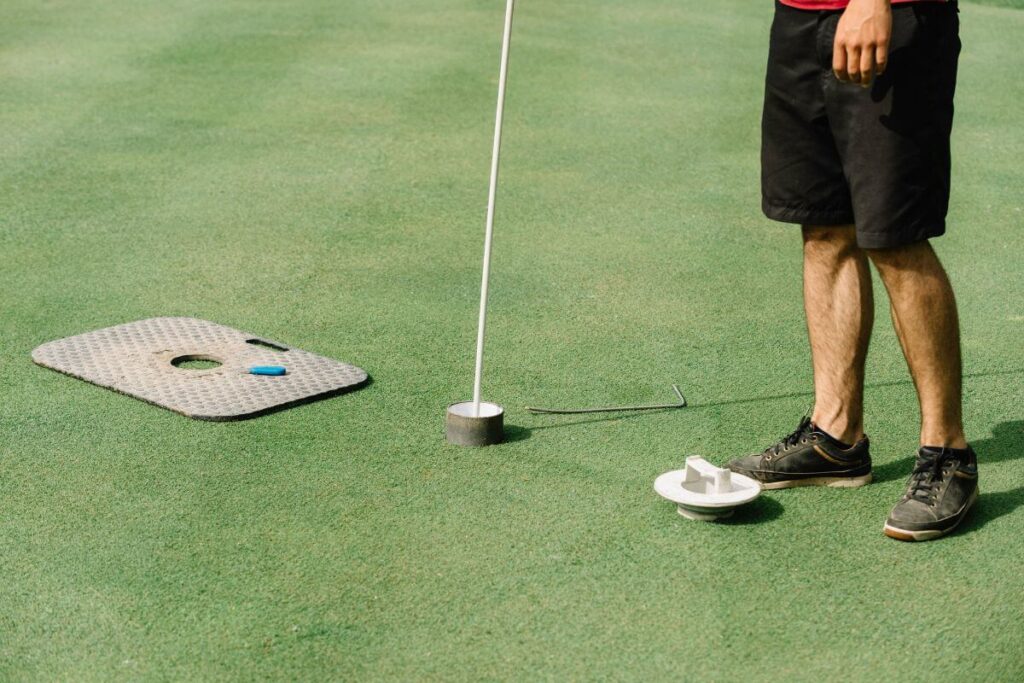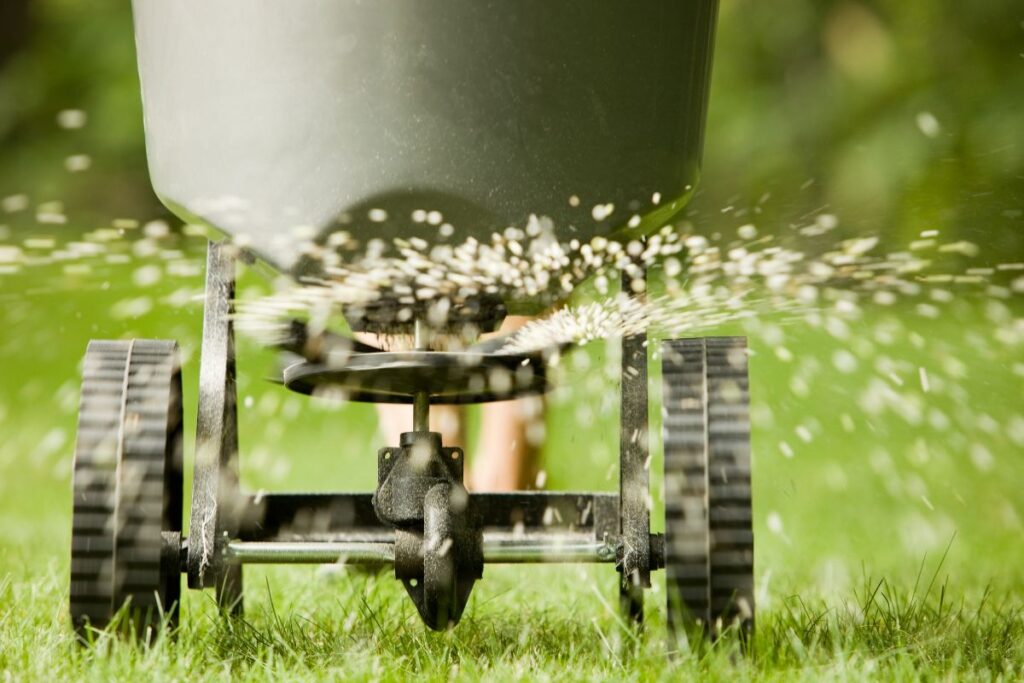When superintendents speak of the rough, they are referring to the grassed areas immediately in front of the tee, adjacent to the fairways, and on both sides of, as well as behind, the green.
Today, the rough on North American courses is, as a rule, maintained in the two-inch range, fertilized, watered regularly, and is comparable in quality to the lawns of many homes.
Presently, many North American courses also include areas in the rough that are environmentally friendly that contain native grasses, wildflowers, bird sanctuaries, and other animal habitats.
The rough may render distinct impressions on various golf courses around the world. The rough area may include unkempt grass, gorse, heather, shrubs, and also naturalized areas.
The rough on our courses in North America is very much like the fairways of a half-century ago. During the growing season, the rough is trimmed regularly, often twice a week, and also fertilized so that it will be thick.
The weeds in the rough are sprayed as needed, and occasionally the turf is treated for fungus disease. The golfers in America are amongst the most pampered players in the world.
They play on the slickest greens, the flattest tees, and the smoothest fairways, but nowhere are they more spoiled than by the grooming of the rough. Golfers on our courses rarely lose a ball unless it is hit into the water or out of bounds. Clearly, the rough receives a great deal of care.
Table of Contents
Defining the Rough Area
In terms of the total area of the golf course, the rough occupies the largest acreage. A typical 18-hole course is built on approximately 150 acres. Following is a breakdown of the land area devoted to each playing area:
Greens: 2–3 acres, 2%
Water/Wetland: 5–15 acres, 9.3%
Tees: 3–4 acres, 3%
Naturalized Areas: 10–25 acres, 11%
Fairways: 25–35 acres, 20%
Rough: 80–95 acres, 56%
Sand: 1 acre, 0.7%
Obviously, these are approximate figures of breakdown and percentages that can vary somewhat from course to course. In any case, because of the large area it encompasses, maintaining the rough when it is actively growing is a mammoth job.
When the rough cutters go out in the morning, they are like a swarm of locusts, devouring the long grass in front as they move and leaving behind a sward of neatly trimmed grass that pleases even the most particular golfer.
Cutting the Rough
Rough needs to be cut routinely and when properly maintained will help the speed of the game. Some superintendents will mow a secondary cut, also known as an intermediate cut, which is cut higher than the fairway and shorter than the height of the rough.
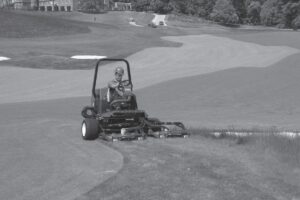
This cut is approximately 5 to 6 feet wide along the outside edge of the fairway that transitions into the rough. This additional process will help golfers with their shot as they hit off the secondary cut.
The cut needs to be uniform so that playing conditions do not vary throughout the course. In prior years, a set of tractor-drawn reel mowers were often used.
Now this piece of equipment is seldom found in the maintenance inventory, mostly because of the increased cost of upkeep and newer, more efficient equipment that has been introduced.
To cut all the rough, superintendents use a combination of some of the following pieces of equipment:
- Several rotary-type mowers of varying widths, either self-propelled or tractor-drawn
- One or more riding triplex or fiveplex reel-type mowers, also known as trim mowers
- Several hand rotary mowers as well as a number of string trimmers.
An 18-hole course, especially in the springtime when the grass is actively growing, may require a larger than normal share of the crew to cut the rough.
With familiarity of the rough area and an understanding of the work at hand, a well-organized superintendent will be able to coordinate the responsibilities of all the workers.
It stands to reason that the largest area should be cut by the fastest and the largest machine. In most cases this is a self-propelled rotary mower with multiple decks, a set of tractor-drawn rotary mowers, or a combination of the two mowers.
The smaller rotaries are used to cut around and between trees. The riding triplex rotary mowers or reel-type mowers are ideal for steep banks around tees and bunkers. Also, hand trimmers and handpushed rotary mowers are useful to pick up the grasses that are left behind by the other mowers.
Cutting the rough is a team effort, and the results are best when all well-trained participants know their assignments and work together. In that manner, the work gets completed quickly and the entire course is constantly kept trimmed.
In the spring when there are sudden surges of growth the rough will need to be cut often. The challenge is to maintain the rough by keeping the crew one step ahead of the growing grass.
The worst scenario imaginable is a warm rain on a Thursday in spring, followed by a long weekend. In just hours, the grass will burst from its roots and provide a thick green carpet that grows faster than the mowers can cut.
Changes in the weather can cause rapid growth and the golfers will experience inconsistencies in the playing conditions: In some areas, the rough will be freshly cut and of perfect playing height; in other parts of the rough the grass will be much too long and golfers will waste time looking for balls.
Therefore, turf managers should be prepared for long weekends or any weekends in the spring that coincide with periods of rapid growth. The greens crew should be willing to work overtime, or the rough will get out of hand and the superintendent is likely to receive phone calls and e-mails from angry golfers.
Riding mowers on steep slopes present a distinct problem. The turf must be dry when sloped areas in the rough are to be cut. Because of safety concerns and the high degree of difficulty, the slope should be cut only by the most experienced operators.
Machines
The machines need to be in the best of mechanical condition, each with the required safety equipment for the operator. Manufacturers build mowers with mechanically adjustable seats, so that the operator can be seated horizontally while the mower cuts a steep slope.
Steep slopes can be very dangerous; all precautions should be used when mowing, and if at all possible the slope should be left to grow naturally. Steep, grassy banks in the rough are especially difficult to keep trimmed.
The wheel-less “Flymo” performs admirably in such areas, but it is an arduous task to handle such a mower on a continuous basis. These areas can also be trimmed with the use of string trimmers.
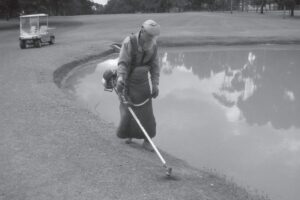
Both pieces of equipment should be operated by expert handlers, otherwise the end result will be a series of scalps and misses that will continue to look ugly long after the work has been completed.
Those who watch televised golf on the weekends may notice the beautiful striping exhibited at tournament sites not only on the fairways but also in the rough. Turf managers talk about this decorative method as striping, which refers to the creation of alternate light and dark green stripes.
Striping can be enhanced by installing solid rollers on rotary cutting units. Some superintendents will encourage their workers to imitate the different art designs by the use of striping at their place of work. Golfers will also be impressed by and appreciative of the creations.
The Dew Walk
Superintendents at many courses now cut a strip from 5 to 10 feet wide through the rough from the front edge of the tee to where the fairway starts. This path is for the golfers who walk, so they won’t get their feet wet and is, therefore, known as a dew walk.
It is maintained like the fairway but cut at a slightly higher height, and it is watered and fertilized in a like manner. It may be necessary from time to time to move the path a few feet in either direction, so that the turf will not wear out and die.
The practice of cutting a dew walk has spread rapidly as a result of televised golf and has gained wide acceptance among golfers. If the superintendent is apprehensive about introducing a dew walk, one might consider adding one or two walks to see if they are acceptable to the golfers.
Maintaining Small but Difficult Rough Areas
No matter how diligently the cutters operate large mowers in the rough, there is always some long grass left behind in areas that can only be cut with small rotary mowers or with string trimmers.
At every golf course, there is a routine of trimming around trees and other hard-to-get-at places. The course takes on an unkempt appearance when such routines are not followed.
The best time to complete this work is immediately following the operation of the larger rough-cutting units. In this manner, the entire area will look uniformly maintained.
Most important, the rotary crew should be led by an experienced person. The leader will look after fueling the machines, making small repairs and adjustments, and most important, making decisions about what area needs to be cut next.
Aspiring assistants often get their first experience at personnel management as rotary crew leaders. We emphasize that such a leader should be a working leader and not someone who stands around idly while others labor.
Careless rotary mower operators can easily cause damage to the bark of small trees. The threat is even greater with the use of string trimmers.
The small trees can be protected by surrounding the trunks with mulch or placing short pieces of flexible drainage tile around the base. Superintendents, in an effort to save time, will spray around the bases of trees with glyphosate or Roundup®, which eliminates the use of trimmers and, thus, preventing damage to the bark.
This widely used grass killer affects only the grass and not the bark of the trees or the roots. This application must be sprayed by an experienced technician, and precautions must be taken when moving with the sprayer from tree to tree, so that the drippings of the liquid from the sprayer do not fall on desirable turf.
One or two applications around the tree bases during the course of a season will eliminate the need for trimming.
The Fescue Rough
Recently, fescue rough has come in vogue on golf courses, and golf course architects now often specify seeding some of the secondary rough with homogenous stands of fescue grass.
Such turf requires infrequent cutting and can look quite spectacular, especially when the wind blows and moves the stems and seedheads like waves on water. This action brings an element of tranquility to a golf course that may have once been absent.
Superintendents who think that fescue rough is maintenance-free are sadly mistaken. Very quickly the sparse turf is invaded by a variety of weeds that make the fescue rough unsightly.
Such weeds must be removed, and because weed spraying in fescue rough is not always advisable, milkweeds, burdocks, goldenrod, and thistles are often pulled out by hand, an arduous job, to say the least.
When the fescue rough encroaches on the playing areas, it results in golfers losing balls and slowing down the pace of play. Superintendents should be observant and look for excessive concentrated foot traffic in the long grass, which is an indication that many golfers are looking for lost balls.
These areas should be trimmed shorter to speed up play. Rough areas that are out of play add an element of beauty to golf, but if allowed to expand and start to interfere with the regular flow of the game, such beauty can quickly become a trodden-down, unattractive hazard.
From time to time, the fescue rough may also need to be cut to preserve the natural look. The fescue can be cut with a tractor-driven rotary mower, flail mower, or farm-type sickle bar mower at a height of at least 6 inches.
Needless piles and/or clumps of clippings should be removed. From time to time, herbicides may need to be applied to control the weeds.
Final Thoughts
There are times when superintendents have wonderful opportunities to leave living legacies. Letting the grass grow in out-of-play areas and planting trees and wildflowers are examples. Such havens of tranquility, where birds make nests and rabbits scurry, are proof of the superintendent’s role as an environmentalist.
A rough may mean different things to different people, and golfers and superintendents rarely agree on what actually describes the rough.
To the golfer the rough is a meaningful punishment for errant shots. For the superintendent the rough provides an opportunity to frame the fairways on the course in a natural way. A rough is never static. It changes with the seasons, it changes over the years with the encroachment of natural growth, and it also changes as a result of humans’ interference with nature.
Whatever form or shape a rough takes, it usually provides character and contrast on a golf course. If a rough provides a challenge as well, then most players will also be happy.

